Astronomy Night At Old Ranch

Ready For A Super Evening?
Astronomy (from the Greek words astron (ἄστρον) "star" and nomos (νόμος) "law") is the scientific study of celestial objects (such as stars, planets, comets, and galaxies) and phenomena that originate outside the Earth's atmosphere (such as the cosmic background radiation). It is concerned with the evolution, physics, chemistry, meteorology, and motion of celestial objects, as well as the formation and development of the universe.
Astronomy is one of the oldest sciences. Astronomers of early civilizations performed methodical observations of the night sky, and astronomical artifacts have been found from much earlier periods. However, the invention of the telescope was required before astronomy was able to develop into a modern science. Historically, astronomy has included disciplines as diverse as astrometry, celestial navigation, observational astronomy, the making of calendars, and even astrology, but professional astronomy is nowadays often considered to be synonymous with astrophysics.
Since the 20th century, the field of professional
astronomy split into observational and theoretical branches.
Observational astronomy is focused on acquiring and analyzing data,
mainly using basic principles of physics. Theoretical astronomy is
oriented towards the development of computer or analytical models to
describe astronomical objects and phenomena. The two fields complement
each other, with theoretical astronomy seeking to explain the
observational results, and observations being used to confirm
theoretical results.
Amateur astronomers have contributed to many important astronomical
discoveries, and astronomy is one of the few sciences where amateurs can
still play an active role, especially in the discovery and observation
of transient phenomena.
A Wonderful Dinner Got The Evening Off To A Great Start

David is preparing Steak Diane at the table. The gives a new
meaning to the term "arm's length"
The Story Unfolds
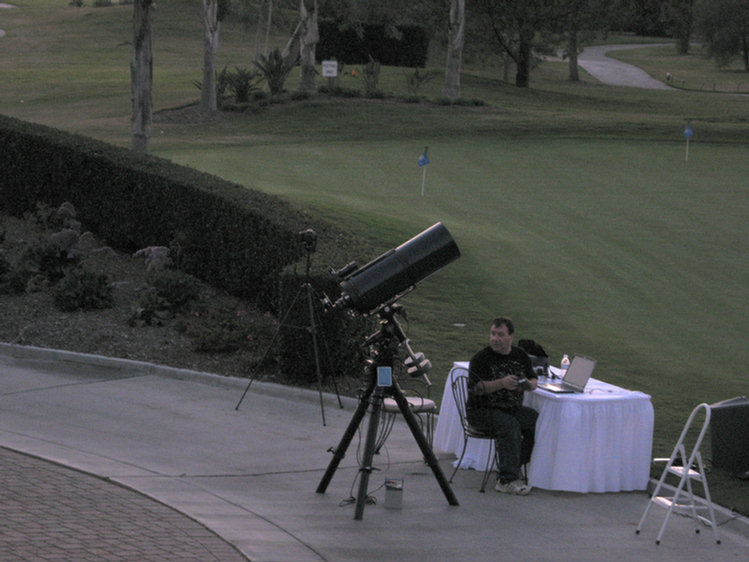
Our astronomer is setting up the telescope using the computer to locate the telescope in time and
space

The telescope has a ten inch
aperture meaning is can collect a lot of light!
A telescope is an instrument designed for the observation of remote objects and the collection of electromagnetic radiation. The first known practically functioning telescopes were invented in the Netherlands at the beginning of the 17th century. The name "Telescope" (from the Greek tele = 'far' and skopein = 'to look or see'; teleskopos = 'far-seeing') was coined by an unidentified Greek poet/theologian who was present at a banquet held in 1611 by Prince Federico Cesi and the name was given to a version of the instrument constructed by Galileo Galilei.
In optics, an aperture is a hole or an opening through which light is admitted. More specifically, the aperture of an optical system is the opening that determines the cone angle of a bundle of rays that come to a focus in the image plane.

Final adjustments are made using the first available stars
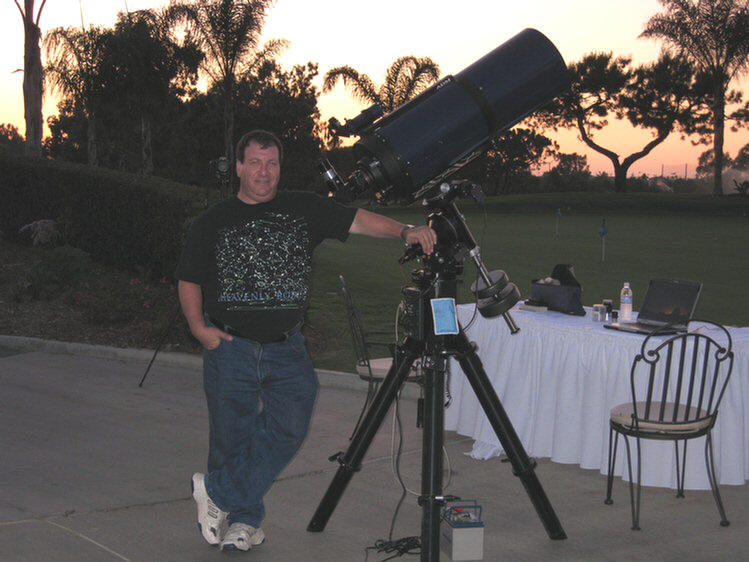
The man and his machine (Craig Bobchin) are ready to explore the universe!
Craig Bobchin has been involved in astronomy for over 30 years. He has been a member of the Orange County Astronomers for 6 years and has served on the board as a trustee and Vice President. He is also involved with the club's outreach program where club members bring their telescopes to schools and parks and teach children and their parents about the night sky. He is a published author with over 200 articles and one book to his name. He can be reached at
Craig@Astronomy4You.com or 714-721-3273.
See his website
http://www.astronomy4you.com for additional information.
The Evening Sky Map Gives Us A Hint At What We Might See
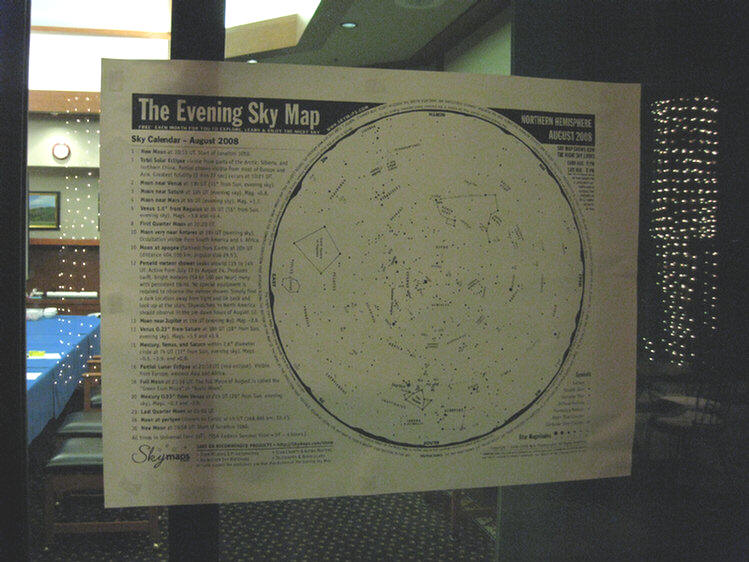
You can see the star map
interactively on the web!
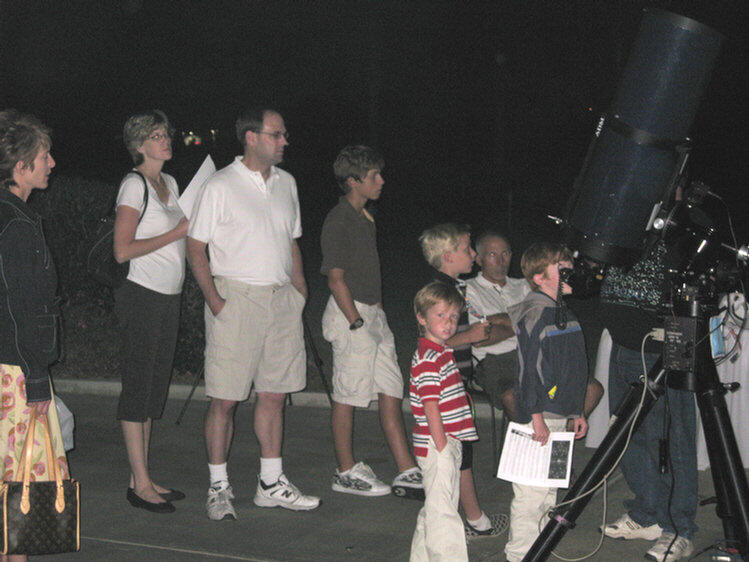
Everybody gets into the act from kids to grandpa's!
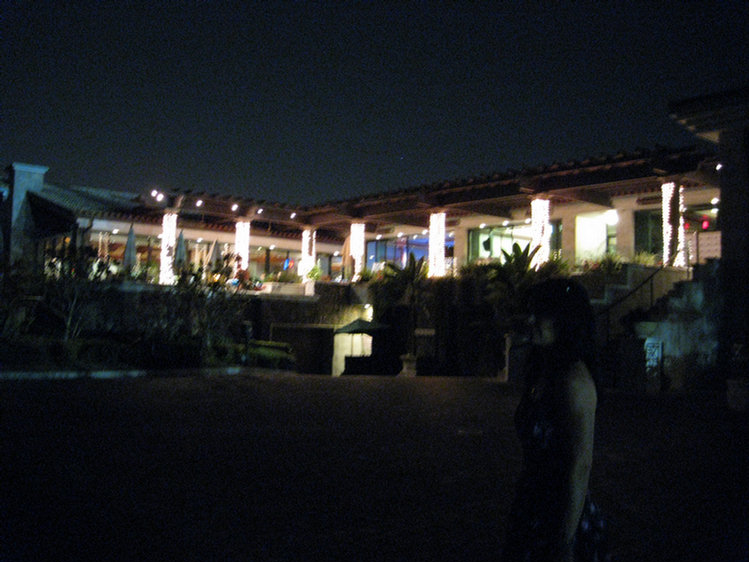
Old Ranch (except for the lights) is a perfect place. Great food
inside and great views outside!

One can see on the computer the area of the sky that the telescope is
aiming at!

Our astronomer was very knowledgeable and could answer questions in an
understandable way!

The computer generated star maps assisted us in understand what we were seeing through the telescope!

We would mention a star and voila, the computer would point the
telescope in that direction.
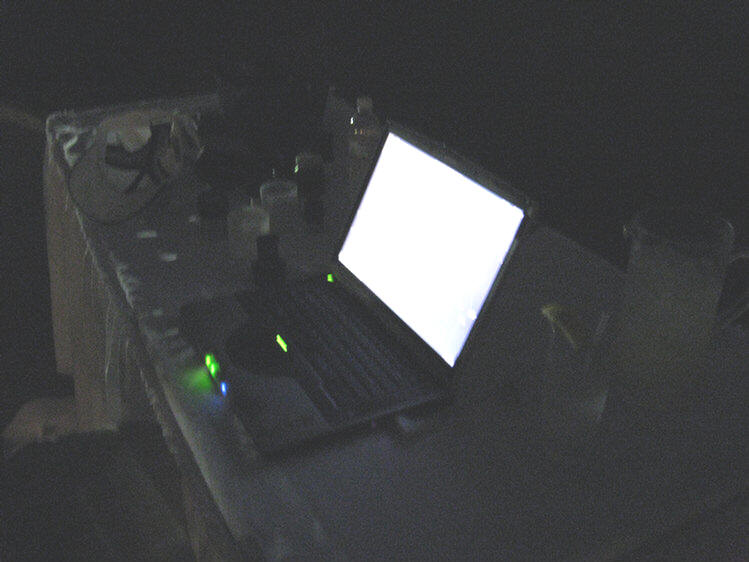
The kids understood the computer and the oldsters understood the
telescope, it was perfect!
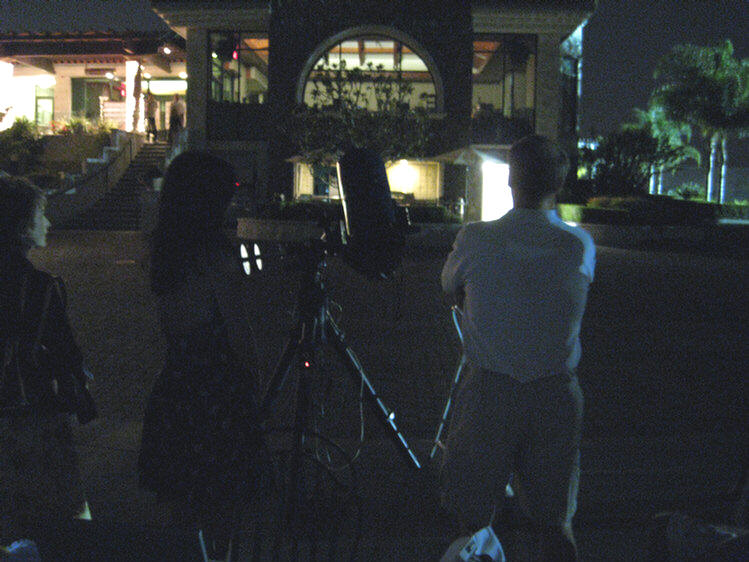
No, we were not looking into the Pro Shop! We were looking at
Jupiter and her four moons!
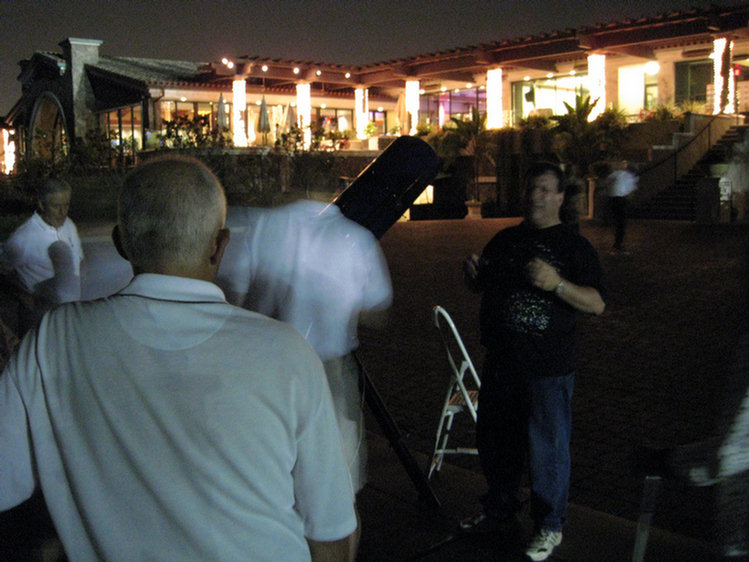
Everybody was excited and was asking questions.... Light Years?
Astronomical Units? It brought back a lot of high school and
college terminology for the older folks and amazement for the kids!

The telescope was easily accessible
Historically, optical astronomy, also called visible light astronomy, is the oldest form of astronomy. Optical images were originally drawn by hand. In the late nineteenth century and most of the twentieth century, images were made using photographic equipment. Modern images are made using digital detectors, particularly detectors using charge-coupled devices (CCDs). Although visible light itself extends from approximately 4000 Å to 7000 Å (400 nm to 700 nm), the same equipment used at these wavelengths is also used to observe some near-ultraviolet and near-infrared radiation.
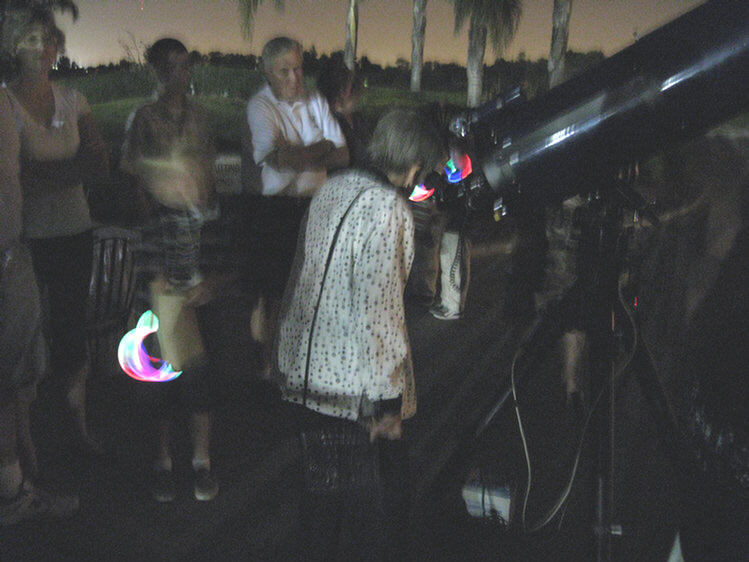
The moons of Jupiter were clearly visible with the telescope.
Although claims are made for the observation of one of Jupiter's
moons by Chinese astronomer Gan De in 364 BC, the first certain
observations of Jupiter's satellites are those of Galileo Galilei in
1610, who sighted the four large Galilean moons with his 33x telescope.
No additional satellites were discovered until E.E. Barnard observed
Amalthea in 1892. Further discoveries, aided by telescopic photography,
followed quickly over the course of the twentieth century, and by 1975,
before the Voyagers reached Jupiter, the planet was known to have at
least thirteen satellites.
The Voyager 1 mission discovered three inner moons in 1979, bringing the
total then known to 16 (17 if one counted Themisto, which had been found
but then lost in 1975). The total rested there until 1999. Since then,
researchers using sensitive ground-based detectors have recovered
Themisto and found a further 46 tiny moons in long, eccentric, generally
retrograde orbits. They average 3 kilometres in diameter, and the
largest is barely 9 km across. All of these moons are thought to be
captured asteroidal or perhaps cometary bodies, possibly fragmented into
several pieces, but very little is actually known about them. The total
number of known moons of Jupiter now stands at 63, currently the most of
any planet in the solar system. Many additional tiny moons may exist
that have not yet been discovered.

We were able to see the four moons of Jupiter!

"This is a lot of fun and interesting too!"
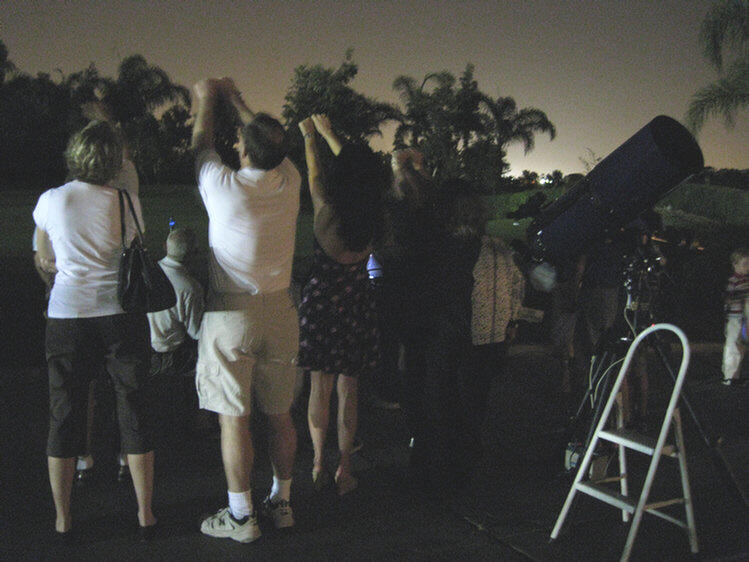
We were trying to locate an object with our naked eye before the
telescope is brought to solve the problem!

The computer connection enticed the kids!
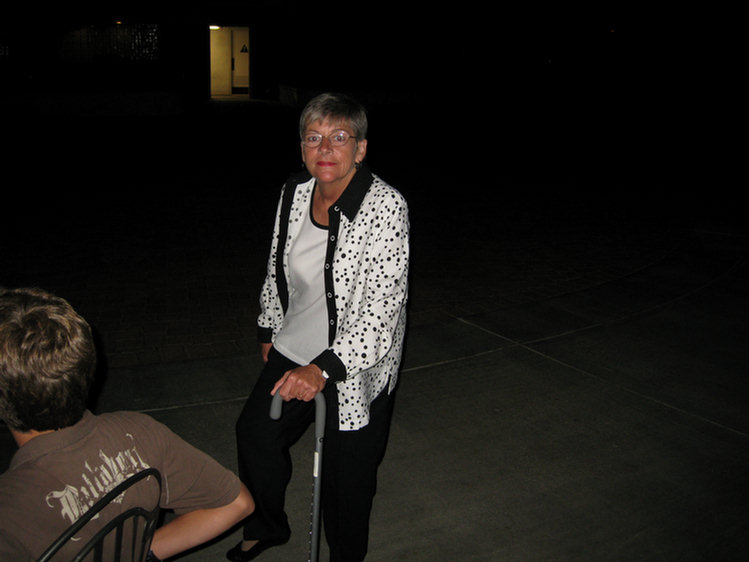
Sue enjoyed the entire event!

Our astronomer could use the computer to assist in answering questions
such as distances and timescales
The astronomical unit (AU or au or a.u. or sometimes ua) is a unit of
length based on the distance from the Earth to the Sun. The precise
value of the AU is currently accepted as 149,597,870,691 ± 30 metres
(nearly 150 million kilometres or 93 million miles).
Aristarchus of Samos estimated the distance to the Sun to be about 20
times the distance to the moon, whereas the true ratio is about 390. His
estimate was based on the angle between the half moon and the sun, which
he estimated as 87°.
According to Eusebius of Caesarea in the Praeparatio Evangelica,
Eratosthenes found the distance to the sun to be "σταδιων μυριαδας
τετρακοσιας και οκτωκισμυριας" (literally "of stadia myriads 400 and
80000"). This has been translated either as 4,080,000 stadia (1903
translation by Edwin Hamilton Gifford), or as 804,000,000 stadia
(edition of Édouard des Places, dated 1974-1991). Using the Greek
stadium of 185 to 190 metres, the former translation comes to a
far-too-low 755,000 km, whereas the second translation comes to 148.7 to
152.8 million km (accurate within 2%).
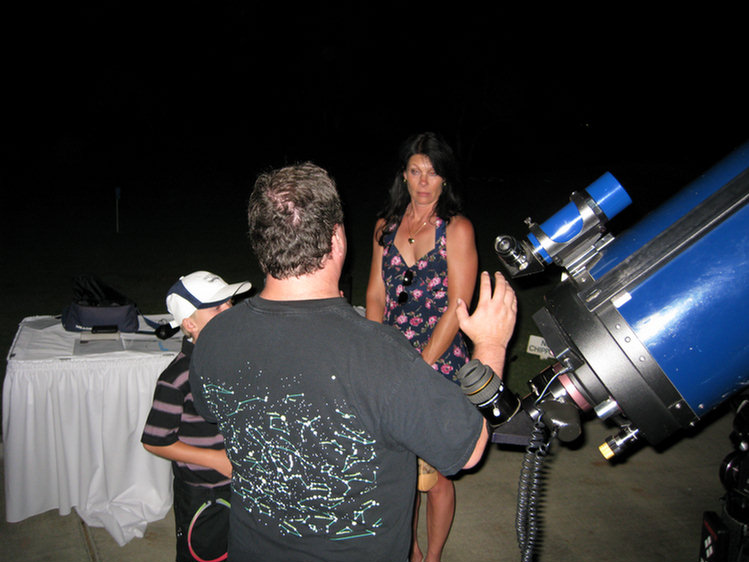
Pretty girls made the astronomers job even more fun!

"What should we look at next?"

There were games on the putting green before the telescope was used!

The telescope was a pretty complex device!

Old Ranch is a wonderful place to belong!

Operating as a system, the telescope and computer are a load of fun!
What is there to see in he night sky. Check the web for any month!

The computer enhances viewing doing tings like turning on the
constellation markings

Checking alignment; the hand held device controls the telescope!

"OK, hold up your hands and look for the star just to the right of
the......."

Everybody was thrilled! Trying the explain that we are seeing
light that was generated millions of years ago was a challenge! We
are viewing history!
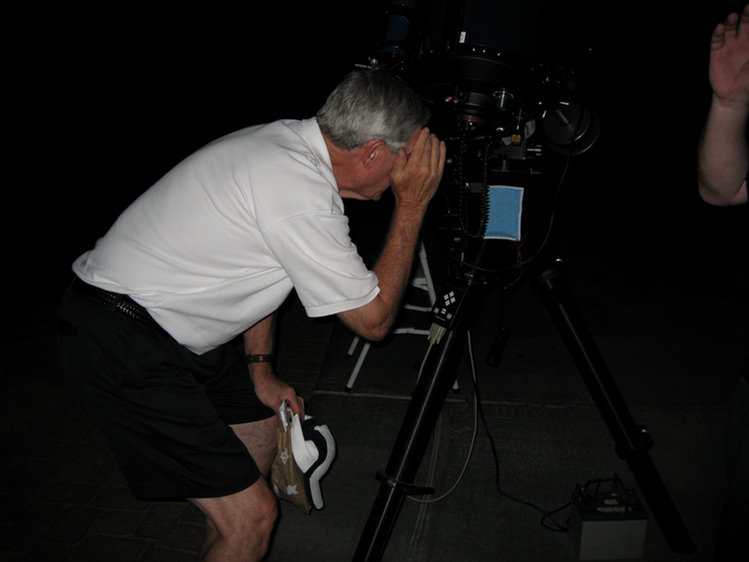
The wonders of space!
We Saw Andromeda As It Existed 2,500,000 Years Ago!
The Andromeda Galaxy (IPA: /ænˈdrɒmədə/, also known as Messier 31,
M31, or NGC 224; often referred to as the Great Andromeda Nebula in
older texts) is a spiral galaxy approximately 2.5 million light-years
away in the constellation Andromeda. It is the nearest spiral galaxy
to our own, the Milky Way. As it is visible as a faint smudge on a
moonless night, it is one of the farthest objects visible to the naked
eye, and can be seen with binoculars even in urban areas.
Andromeda is the largest galaxy of the Local Group, which consists of
the Andromeda Galaxy, the Milky Way Galaxy, the Triangulum Galaxy, and
about 30 other smaller galaxies. Although the largest, it may not be the
most massive, as recent findings suggest that the Milky Way contains
more dark matter and may be the most massive in the grouping. However,
recent observations by the Spitzer Space Telescope revealed that M31
contains one trillion (1012) stars, greatly exceeding the number of
stars in our own galaxy.[8] 2006 estimates put the mass of the Milky Way
to be ~80% of the mass of Andromeda, which is estimated to be 7.1×1011
solar masses.
At an apparent magnitude of 4.4, the Andromeda Galaxy is notable for
being one of the brightest Messier objects, making it easily visible to
the naked eye even when viewed from areas with moderate light pollution.
It appears quite small without a telescope because only the central part
is bright enough to be visible, but the full angular diameter of the
galaxy is seven times that of the full moon.

So this is where all of the 1950's science fiction monsters came from?
Dressing For The Adventure Was Important

Some people come dressed for the occasion!

Astronomer in training!

Light is the enemy and of course guess who is taking flash photography?

Our hero! What a wonderful evening!
